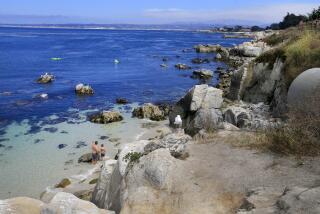Trump may strip protections from 10 national monuments
The Trump administration’s plan for shrinking and diminishing protections at America’s national monuments appears far more expansive than previously reported, targeting 10 of the nation’s most ecologically sensitive landscapes and marine preserves.
The plan, which the White House has been keeping secret since it was submitted by Interior Secretary Ryan Zinke late last month, would shrink the borders at half a dozen monuments and ocean preserves and open four others up for uses such as commercial fishing, logging and coal mining, according to a copy of the blueprint obtained by the Wall Street Journal and Washington Post.
The Zinke plan, if adopted, will have limited effect in California. Only one of the monuments targeted, the Cascade-Siskiyou on the Oregon border, has land in the state. Zinke did not specify in his 19-page memorandum how the boundaries of that or any of the other public lands targeted should be changed.
But the impact on the West overall would be dramatic. The other monuments Zinke is proposing to shrink include Bears Ears and Grand Staircase-Escalante in Utah, which together encompass 3.2 million acres. Zinke is also urging a downsizing of the nearly 297,000-acre Gold Butte National Monument in Nevada.
Under Zinke’s plan, the boundaries of the 584,000-square-mile Pacific Remote Islands Marine National Monument would be reduced so that commercial fishing could resume in the territory. The monument, which encompasses seven atolls and islands, is described by the U.S. Fish and Wildlife Service as “one of the last frontiers and havens for wildlife in the world.”
Zinke also wants commercial fishing to resume within the 13,451-square-mile Rose Atoll Marine National Monument near American Samoa, which the National Oceanic and Atmospheric Administration describes as “one of the most pristine atolls in the world.” Like Pacific Remote Islands, it provides refuge to a number of endangered and threatened species.
The White House is refusing to comment and has not said when it will make a final determination.
“No president should use the authority under the [Antiquities] Act to restrict public access, prevent hunting and fishing, burden private land, or eliminate traditional land uses unless such action is needed to protect the object,” Zinke wrote in his memo to President Trump, who ordered the review of the monuments. He concluded that Trump has the authority to unilaterally change the boundaries of monuments.
But that is a matter of intense debate. No president has ever stripped protections from monuments in the way Zinke is proposing. Opponents of the plans, including state attorneys general, environmentalists, tribal associations and outdoor groups have all vowed to fight the administration in court should it pursue the Zinke blueprint.
“Acting on these recommendations would represent an unprecedented assault on our parks and public lands, and undermine bipartisan progress to protect our lands and waters that dates to Theodore Roosevelt,” said Jamie Williams, president of the Wilderness Society. “We believe the Trump administration has no legal authority to alter or erase protections for national treasures.”
At stake are millions of acres of unique geological formations, rare archaeological artifacts and pristine landscapes and seascapes. Trump had complained that past presidents abused their authority to put land off-limits to development and designated ever-growing swaths of property as monuments at the behest of environmentalists.
The review of the monuments undertaken by Zinke drew fury from Native American groups, conservationists, outdoor enthusiasts and political leaders. More than 90% of the 2.7 million Americans who weighed in on the monument review in written comments to the Interior Department were opposed to shrinking borders. Zinke acknowledged the intense opposition in his report to Trump, but attributed it to “a well-orchestrated national campaign organized by multiple organizations.”
Beyond the half a dozen monuments where Zinke suggests borders be redrawn, there are several more that he proposes be opened to “traditional uses” such as logging and coal mining. They include the fledgling Katahdin Woods and Waters National Monument in Maine, which would be opened to more logging. Commercial fishing restrictions would be lifted from Northeast Canyons and Seamounts National Monument southeast of Cape Cod. The Rio Grande del Norte National Monument near Taos, N.M., would be opened up to more grazing. And restrictions could be lifted on motor vehicles at the Organ Mountains-Desert Peaks National Monument on New Mexico’s southern border, which Zinke says is necessary so that the federal government can better combat drug smuggling.
The plan to change the 10 monuments comes after Trump directed Zinke to review 27 monuments larger than 100,000 acres that had been established since the presidency of Bill Clinton.
During the course of the review, Zinke declared — with little explanation — that a dozen monuments deserved to remain fully intact, including Sand to Snow in California. By late August, Zinke had privately delivered the highly anticipated report to the White House. The administration’s refusal to reveal what monuments were targeted drew yet more ire from opponents, who charged that the process lacked transparency.
Some lawmakers are likely to warmly embrace the proposal. Politicians in Utah had lobbied Trump to eliminate the 1.3-million-acre Bears Ears National Monument in the remote desert Canyonlands of their state altogether. President Obama’s creation of the new monument enraged state officials who complained it killed off potential oil, gas and mining jobs in the region.
The monument was created at the behest of five tribal nations eager to protect more than 100,000 cultural and archaeological sites that they fear are vulnerable to looting and grave robbing.
The dispute over monuments in Utah stretches back to the Clinton administration, whose creation of the 1.9-million-acre Grand Staircase-Escalante National Monument riled some residents. A proposed coal project was derailed with that action.
Even before Trump ordered the review, the campaign against Bears Ears triggered an intense backlash, in which outdoor apparel company Patagonia led a boycott effort that cost Salt Lake City a major trade show that had been providing an economic boost to the city for 20 years.
The administration’s plan is rooted in a provision of the 1906 Antiquities Act that it argues limits presidents to protecting the smallest possible amount of land needed to preserve historic artifacts and ecologically significant landscapes.
Zinke’s memorandum also suggested Trump might consider creating some modestly sized monuments and parks. He said the 4,000 acres of Camp Nelson, an 1863 Union Army supply depot, training center and hospital in Kentucky, might be deserving of protection, along with the Medgar Evers Home in Jackson, Miss. He also suggested Trump consider the 130,000-acre Badger-Two Medicine area in the forest of northern Montana, an area Zinke said is sacred to the Blackfeet Nation.
Twitter: @evanhalper
ALSO
Trump’s first speech at U.N. will focus on sovereignty and calls for reform
Trump crosses yet another line on Twitter days before U.N. address
Tillerson trims State Department staff and vows to make diplomacy more efficient
UPDATES:
1:15 p.m.: The article was updated with details about new monuments Zinke is recommending.
This article was originally published at 9:55 a.m.
More to Read
Get the L.A. Times Politics newsletter
Deeply reported insights into legislation, politics and policy from Sacramento, Washington and beyond. In your inbox three times per week.
You may occasionally receive promotional content from the Los Angeles Times.







